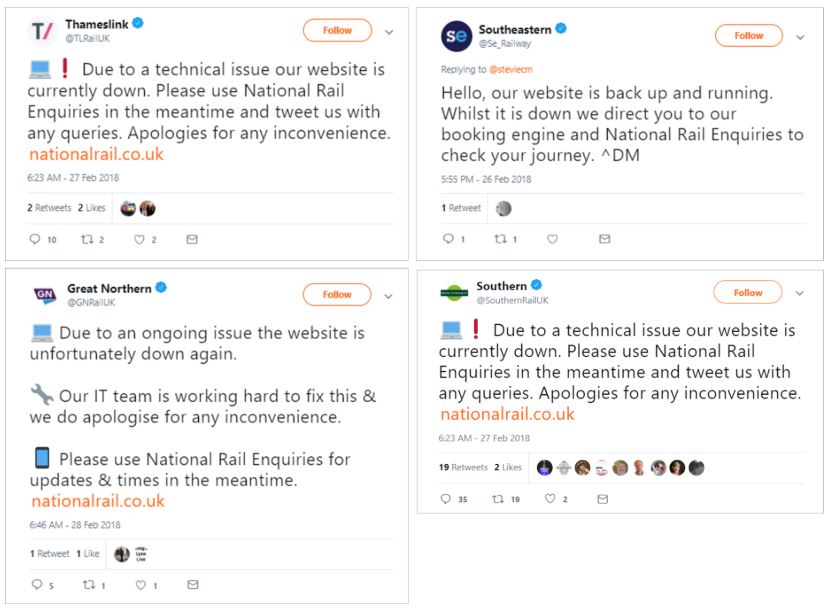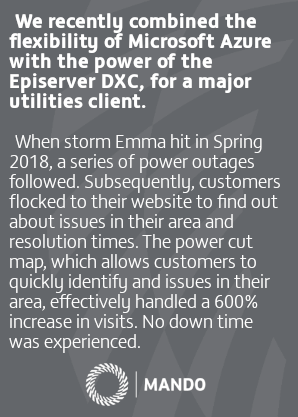Is your CX stormproof?
Written by Luke Stamper
With different audiences to serve, including many vulnerable groups, are you able to ensure that your content and messaging is personalised, to communicate in the best way with these highest priority customers?
Utilities, Energy and Transport companies tend to dread the winter season. Plummeting temperatures, heavy winds and snowfall can wreak havoc on pipes, power lines and transport links, often revealing issues with digital infrastructure too. As the UK is struck by the strong winds and heavy rainfall from Storm Ciara, Dennis and with Storm Jorge set to batter Britain with 70mph winds this weekend, suppliers have the opportunity to engage with their customers – and impress.
In recent years, waves of intense weather conditions such as 2018’s Beast from the East shone a light on a number of holes in company’s customer experience strategies and the systems that underpin it. Ofwat berated water companies after 40% of customers in seven of the worst affected areas received no communication during the incident. Whilst a host of rail websites failed to handle the masses of customers attempting to find out if their service was still running.

Customer interactions with utilities companies tend to be few and far in between. Provide a poor experience when your customers need you most, and you’ll leave a terrible lasting impression, likely coupled with a loss of revenue from regulatory fines and customer compensation pay-outs.
If you exceed customer expectations during a crisis, you’ll enhance your reputation, increase customer satisfaction scores and build loyalty.
So, with Storm Jorge forecasted over the weekend, and with most of Scotland and the North of England set to receive heavy snowfall, how do you prepare for major incidents and the subsequent flurry of customer contacts that follow?
A defined CX strategy for crisis situations
Proactive, personalised communications
Customers who are warned pre-emptively about potential disruption to their service are far less likely to get in touch when an incident does occur.
Companies need to break down data silos, and correlate data relating to vulnerable areas of infrastructure with customer information, to proactively communicate to customers if their anticipate issues in their region.
Customers – particularly those most vulnerable during disruptions to service – can then take their own precautions to deal with any issues that follow; be that stocking up on water bottles in pipes are likely to freeze or leak; making arrangements to stay at a family or friends’ if power is likely to go out; or planning an alternative journey if issues with transport links are expected to arise.
Widening the channels of engagement
There’s obvious benefits to widening the channels of engagement; trying to funnel 500,000 customer contacts into three channels is far more difficult than doing so with say, five or six.
Companies need to make it as simple as possible for customers to report problems with their service, and to find information on expected resolution times.
Having additional channels like voice, chatbots or live chat in place can help lessen the pressure on staff manning the call centre – keeping lines free for customers in need of extra support, such as those in vulnerable circumstances – whilst simultaneously reducing cost to serve.
Make the experience effortless and allow customers to get in touch on their preferred channel of choice during a crisis situation, and the lasting impression you will leave is more likely to be a positive one.
The Consumer Council for Water (CCWater) found that during 2018’s freeze-thaw, companies that used all their communication channels and showed a presence on the ground received lower levels of complaints.
… Systems to underpin it
When major incidents like Storm Dennis occur, websites often act as the first port of call for customers seeking information on the disruption to their service.

Companies have to ensure their digital estates are able to handle significant spikes in website traffic – and don’t simply fall over.
Cloud solutions like Microsoft Azure are designed to be elastic; automatically scaling at times of peak demand, then scaling back down once the increased activity dies off.
Digital experience platforms like Sitecore and Episerver have been on the forefront of leveraging Microsoft Azure, whilst unlocking companies’ ability to personalise and optimise the digital customer experience.
It means marketers and digital teams can take advantage of high customer interactions and put the right products, services and content in front of the right audiences, when it matters most.
For utilities companies, that provides an opportunity to drive awareness and sign-ups to their priority services register, whilst transport companies could make use of contextually relevant calls-to-action directing customers to compensation forms – should they not automatically pay out.
With the right CX strategy and technology in place, major incidents and spikes in customer demand provide an incredible opportunity for companies to demonstrate their worth to customers and regulators. Without that in place, you’re destined for poor levels of customer satisfaction.
What else is going on
-
April 2025
Data Engineering: The Foundation for Enterprise Analytics
Why data engineering is the often-overlooked partner to digital analytics implementation-and why bringing both together is the key to unlocking long-term value from your data.
-
April 2025
Transforming Content, Commerce, and Customer Experience: The Power of Optimizely One
A detailed guide to Optimizely One - a fully composable DXP ecosystem designed for businesses seeking scalability and innovation.
